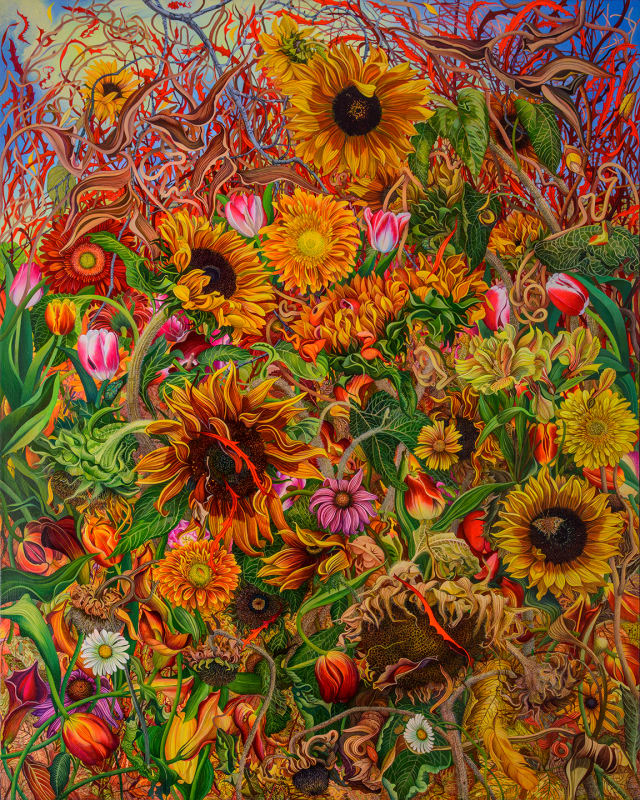Judy Garfin
"Her experiences in other cultures have profoundly influenced her art work, opening avenues into image creation that undermines western concepts of hierarchy and artfulness."
Judy Garfin was born August 30, 1945, in Edmonton, Alberta and raised in Jasper, Alberta and Vancouver, British Columbia. At age 17, She spent a year in Israel before returning to complete her Bachelor of Arts in English Literature at the University of British Columbia and the City College of New York. She studied sculpture at the Art Students League in New York City and painting and printmaking at the Vancouver School of Art with Tamarind Master Printer Robert Bigelow. In 1973, she received her M.F.A. from The Maryland Institute College of Art’s Hoffberger School of Painting directed by abstract expressionist painter, Grace Hartigan. Upon graduation, she won the Walters Art Museum Traveling Fellowship that is awarded to one graduating MFA candidate. She has lived in Israel, New York City, Ireland and Italy and has traveled through Europe, Guatemala, The Galapagos Islands,, India, Thailand and Indonesia as well as across Canada and the United States. Her experiences in other cultures have profoundly influenced her art work, opening avenues into image creation that undermines western concepts of hierarchy and artfulness.
She has won grants for artistic creation from the Canada Council for the Arts, Telefilm, Canada, the Innovative Research Assistance Program (IRAP) of the National Research Council of Canada and FRDP and CASA grants through Concordia University. She and her husband, jazz guitarist and film composer Neil Smolar, founded a new media company in 2001 that since has garnered numerous awards nationally and internationally. She has shown her paintings and prints in solo and group exhibitions in Canada and the United States.
Judy Garfin lives in Montreal where she paints in her studio and teaches graduate and undergraduate courses in Print Media as a tenured associate professor in The Department of Fine Arts at Concordia University. Judy Garfin’s works are in public, corporate and private collections including the House of Commons of Canada, The Canada Council Art Bank, The Kitchener-Waterloo Art Gallery, The Washington State Arts Commission, the Alcan Aluminum, Ivanhoe and Bronfman collections among others
"In l972, I began to work in watercolor. The scale of my early watercolors was intimate and the medium suited my purpose. I looked at Persian painting, Tibetan Tonkas, Byzantine Icons, illuminated manuscripts such as The Haggadah, The Book of Kells and the Books of Hours; how they portrayed concepts of the cosmos, levels of being, myths of origin, recordings of the seasons and cycles of life. I was trying to understand my own cosmos and how to represent it. Over the ten years that followed, I established a visual system of iconography and motifs that presented paradox and simultaneously functioned on many levels for me: psychological and personal; social and cultural; philosophical and metaphysical. I painted images of whole and breaking glass; twisted and loose fabric; spaces that were transparent and opaque; invented and real life forms within rigid and porous definitions.
In l986, I began the series of life-sized watercolors that I call ‘the wrapped figures’. In these paintings, I used the concept of the hidden to represent the self. I represented light as material and worked with the concept of concealment as that which reveals meaning. I was thinking about camouflage and metamorphosis in nature; and character in theatre and literature – most importantly the idea that within the hidden there is a totality – a mystery that is tangible, sensual and able to be experienced. I titled one of my figures The Secret Woman after a short story by Colette. The central character of the story finds her complexity and is freed to express it through costume and disguise. Recently I have found that The Shekhinah (Presence), the feminine Godhead and concealed woman of the Kabbalah, most poignantly captures the essence of these images.
In l990, I returned to canvas for large work and painted on panel for the smaller work. I painted images of dried and living plant forms to describe an interior world rather than to represent external nature. These gardens, in their concrete description and diversity of forms, textures and patterns, are fictions that tell stories about living things. They follow the principle ‘the truer the form, the more powerful the life of the formless within it.’ In my plant paintings, the detailed elements, crowded up at the front are a materialization of the space behind.
My method of working is fused to the content of my painting. I work on a white surface finishing each element before moving on to the next. There is no under-painting or sketch. Each work grows into its own presence element by element on an undifferentiated field."
- Judy Garfin



